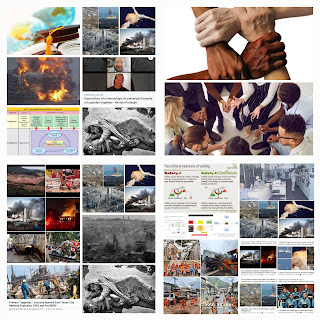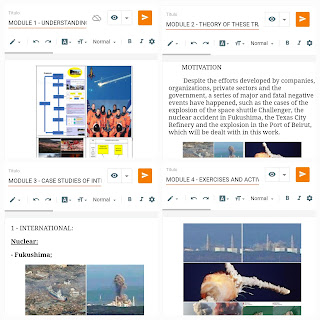Japanese fisheries head opposes a plan to pump treated radioactive water from Fukushima into the sea and RISK MANAGEMENT modules, AND THE PROACTIVE SAFETY METHOD, RISKS AND EMERGENCIES
The head of Japan’s national fisheries cooperatives has reiterated his group’s opposition to the planned discharge of treated radioactive water into the sea from the wrecked Fukushima nuclear power plant, demanding the government take full responsibility for any negative impact on the industry.
“We cannot support the government’s stance that an ocean release is the only solution,” said Masanobu Sakamoto, president of JF Zengyoren, or the National Federation of Fisheries Cooperatives.
A release is expected to begin this summer, though the exact date has not been set.
After a major disaster, when investigators are piecing together the story of what happened, a striking fact often emerges: before disaster struck, some people in the organization involved were aware of dangerous conditions that had the potential to escalate to a critical level. But for a variety of reasons, this crucial information did not reach decision-makers. Therefore, the organization kept moving ever closer to catastrophe, effectively unaware of the possible threats. In the event of an accident, losses and costs for dealing with the consequences are often hundreds — or even thousands — of times greater than the finances that would have been required to deal with the risks when they were first recognized, and before they led to a major accident. Due to the asymmetry of risk information at different levels of the corporate hierarchy of critical infrastructure companies, preventive decisions were not taken in a timely manner. Ultimately, this led to the organizations facing catastrophic events. This observation has been documented in the following major technological accidents: Challenger space shuttle explosion (USA, 1986); Chernobyl nuclear power plant disaster (USSR, 1986); Sayano-Shushenskaya hydropower plant accident (Russia, 2009); Deepwater Horizon oil spill (USA, 2010); Fukushima-1 nuclear power plant disaster (Japan, 2011); methane explosions at American and Russian coal mines in the 2010s, and in several other disasters.
For more information, videos, and complementary materials, about Safety, access the links at the end of this post.
Are we paying attention to the essential issues for the Safety of Organizations?
How many lives, what social, environmental, patrimonial impact, in the image of the organization and others, would be spared?
It is important to look into these issues, and to deepen academic studies, with application in companies, to develop proposals to avoid these tragedies.
Below is the proposal for preventing and mitigating major and fatal negative events, which I developed based on studies and applications in organizations.
It is important to present models, principles and structured forms, together with lessons learned from Major and Fatal Negative Events, which facilitate the analysis of these tragedies, That's why I created the Prevent Tragedy Course - Proactive Safety, Risks, and Emergencies Methodology (ProSREM).
I developed ProSREM, in my Ph.D., in progress, in Production Engineering at UFRJ, and used as academic bases: Ergonomics, Resilience Engineering, Integrated Management Systems (Quality, Safety, and Environment), among other methods and tools, and my database to build this proposal, was the biggest and fatal negative events, prominent in the world and in Brazil, I apply this methodology at Fiocruz, where I am a public servant and in organizations, companies, sectors, and activities.
If you are interested in the proposal, send me an email, and when there is the availability of e-learning training, of the Introductory Course of the Proactive Safety Method, Risks and Emergencies, I can contact you, the email is:
washington.fiocruz@gmail.com
I will send you a form, for your registration, for the e-learning training.
If you are a professional with experience in the area of safety, risk management, or similar areas, the initial training will consist of two 1-hour meetings, plus guided reading of the modules, complementary materials, and other guidelines, which I will send.
I will assemble these training, in order of registration, so speed up yours, to start the course earlier.
This course will be free of charge and will help me at this stage of my research, for the Doctorate in Production Engineering at UFRJ.
Prevent Tragedy Course - Reports of professionals from the course's study cycle:
- They liked the proposal, it lacks this approach with application in the industry (deficiency in the training), very didactic, motivating for the theme, bringing reality, bringing disasters, it could be avoided, ANDEST (National Association of Teachers in Engineering Safety at Work in Brazil) identified a deficiency in risk management in the training of the safety eng., posts of proactive safety are important, you raise the ball, it is up to people to absorb the lessons of the post, I encourage them to understand what happened, think about all the aspects, awaken this need for analysis.
RISK MANAGEMENT modules, AND THE PROACTIVE SAFETY METHOD, RISKS AND EMERGENCIES.
Module 1, UNDERSTANDING AND PREVENTING TRAGEDY:
Module 2, THEORY OF THESE TRAGEDY - SHORT VERSION:
Module 3, CASE STUDIES OF THESE TRAGEDY:
Module 4, EXERCISES AND ACTIVITIES, TO UNDERSTAND AND PREVENT TRAGEDY:
Article approved in JRACR journal - The Sociotechnical Construction of Risks, and Principles of the Proactive Approach to Safety
Participate, specialize and support the dissemination of this initiative.
Washington Barbosa





Comentários
Postar um comentário